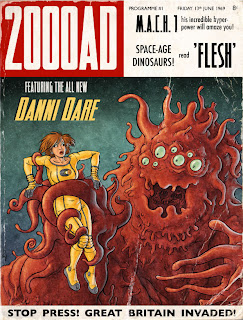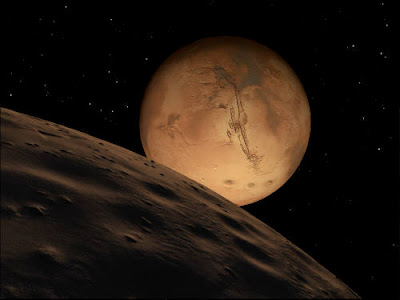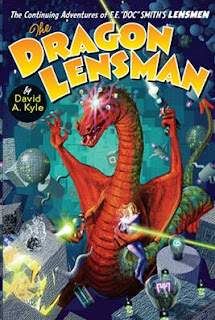Adam Grose is a writer, artist (fine art and illustration), self-publisher and art educator. He dabbles with other forms of media, experimenting with sculpture, music and video. (His image,
What Do You See, right, was shortlisted for the
BBC's Mock Turner Prize in 2005).
"I create various stories, usually in the realm of science-fiction and fantasy," he reveals. "My biggest story to date is
Cosmogenesis: The Chronicles of Quongo with illustrator Tony Suleri, which was written over a period of seven years culminating in an epic 550 page tome.
"Other books I have created include:
The Prison and Other Tales, based on my observations and stories with a twist;
Phoenix: A Warrior's Tale, an onomatopoeia experiment and a series of short stories based in a prison called
HMP Temeraire."
Adam is also the current cover artist for a poetry, prose and art magazine, Reflections, each cover dealing with an aspect of reflection.
Sci-Fi Art Now: What tools do you mainly use to create your art?
Adam Grose: My first love is oil paint on canvas. I create fine art paintings exploring areas to do with 'entropy' (order and disorder).
My comic strip and illustration work ranges from pencil-shaded drawings, built up in successive layers from 2H to 6B, brush and ink and digital via a Wacom Bamboo tablet. I experiment with various tools including; twigs, feathers, rollers, bits of cloth and my fingers. I intend to create some painted comic pages and covers with oil paint in the future.
Sci-Fi Art Now: Why?
Adam: I prefer to draw by hand on paper/ canvas because I still love the hands on approach drawing with pencil, charcoal and painting with brushes. I love pushing paint around on a canvas, building up the glazes, step by step and I love the smell of oil paint and the atmosphere associated with the painting studio. The use of different tools allows me to create various textures.
I bought a Wacom tablet back in February to experiment with digital painting, enabling me to try new ways of drawing. I scan the original piece into the computer and create colouring and texture effects via CS4. I like the way I can change things around and even delete layers that don't work, however, I still prefer creating an original hard-copy on paper instead of only a digital copy.
Sci-Fi Art Now: What inspired you to become an artist?
Adam: When I was young my parents and my sister inspired my love for drawing. My mum used to draw with charcoal and my dad used to paint small oil paintings, usually battle scenes. Later, Rolf Harris' programmes inspired me, teaching me to experiment with various media and using different materials.
I always knew I wanted to be an artist and when I first met Tony Suleri he introduced me to comics,
2000AD and into the world of science-fiction and comics (I later came across a pile of
2000AD comics at a charity shop, starting from prog 11 – fuelling my imagination further). It wasn't long before I discovered DC, Marvel and my local comic shop, 20 miles away in Street, Somerset. I haven't looked back since.
My passion for storytelling, sequential art and fine art has continued to grow, feeding my insatiable appetite for art, artists and creating.
 |
HMP Temeraire - Childhood Survival
by Adam Grose |
Sci-Fi Art Now: What was the most useful piece of advice you were given when you began learning your craft?
Adam: My parents and my sister were always encouraging me to continue drawing, filling Revel Pads like there was no tomorrow. I decided from a young age that if I was going to be any good or considered any good then I would need to practice everyday, carry an A6 sketchbook everywhere, observe life and draw from nature, never shying away from the things I found difficult to draw - because one day I knew it would all click into place and I would understand the mechanics of drawing.
Sci-Fi Art Now: Which artists most inspire you?
Adam: Each of these artists have taught me new ways of seeing and revealed a different technique which has helped further my own style: Frank Auerbach, Rothko, Lucien Freud, Bernie Wrightson, Rembrandt, Michelangelo, Van Gogh, Cezanne, Monet, Turner, Edvard Munch, Vermeer, Frank Frazetta, Alex Raymond, Jack Kirby, Steve Ditko, Brian Bolland, Ray Bradbury, Cam Kennedy, Goya, Titian, Alex Toth, Dave McKean and Frank Miller.
Various Japanese, Indian, African and South American art has also showed me different ways of looking and recording the world around me, especially when I travelled and lived in some of these countries.
Sci-Fi Art Now: What is the appeal to you of science fiction as an inspiration for some of your work?
Adam: I love the 'what if?' aspect that science-fiction lends itself to. You can write about anything and mask it under the label of science-fiction. This allows the writer and artist to allude to current events without having to be blatant.
I believe every creator places current events/ thoughts into their work which may not reveal itself until much later, when looking back. When I look at
Cosmogenesis, I can see how the 'War on Terrorism' and the wars in Afghanistan and Iraq was influencing the direction of the story in some ways. These sub-conscious elements helped expand the original idea.
Underlying events happening at the time of writing/ drawing informs the art and can bring a resonance that people respond to at a deeper level of awareness. Science-fiction, I find, allows people to explore their own understanding of the world around them, how we play our part in shaping reality and sometimes foreshadowing thing to come (
The Drowned World by JG Ballard;
1984 by George Orwell;
Brave New World by Aldous Huxley;
Valis by Philip K. Dick). I'm interested in the human condition and how we manipulate the world around us, furthering understanding of our place in the world and the universe, from the outlandish to the pragmatic, both exploring different realities, inner and outer space.
 |
| Soldier's Grief by Adam Grose - a personal favourite of the artist |
Sci-Fi Art Now: Do you have a favourite piece of work or project you have worked on?
Adam: I loved working on
Cosmogenesis, working out the entire story and its expanded plots. It taught me a lot about writing and how various plots in previous books informed the future books of the six-book series, creating a epic arc while being comprised of nine parts (six books).
I loved writing the characters and how they interact with one another, the way they would speak, react and influence one another. I'm currently working on several stories at the moment, some I will draw and others by other artists.
I'm currently working with Tony Suleri on a new three book series based on a few of the characters from the original
Cosmogenesis series, introducing new characters and some of the worlds seen in the map of the Galaxy of Nom-Yakk. This also gives me the opportunity to create some pre-production drawings, which I love doing, and one of these new characters appears in the
Sci-Fi Art Now book.
I'm also creating a series of paintings under the title 'Plague of War'.
Sci-Fi Art Now:
In your career, have you had any bizarre experiences while creating your art?
Adam: Accidents. When accidents happen I feel it's your inner-mind doing something that your conscious-mind hasn't seen or considered.
For example: When I was going through a period of just painting my eyes the painting I was doing at the time had decided to suddenly fall off the easel, falling on top of the palette. I thought the worse. I lifted it off carefully and luckily the only bit of paint from the palette was a blob of red on the outer edge of the painted eye. I placed it back on the easel and looked at it deciding what I should do. I noticed the blob of red paint looked like a small red skull leaning on its side.
I decided to leave it there, adding to the painting which I had been titled 'Hunter'. The image inside the eye looked like a stag being hunted by me.
I find these accidents influence the original idea and reveal something else, as though they were meant to happen.
Sci-Fi Art Now:
What most frustrates you about being an artist?
Adam: Time and balance. I have to be very conscious of my time management deciding what needs to be realised from thought. I like being able to create everyday and I'm aware that the secret is getting the balance right between my work and work for other publishers and managing time and keeping to a routine. It's all about balance.
Sci-Fi Art Now:
What keeps you going despite the hopefully occasional frustrations?
Adam: I love learning new techniques and skills, reading and looking at other creative work, gaining an understanding about how others overcome their frustrations and problems, in-turn helping me to become a better artist and writer.
Sci-Fi Art Now:
What advice would you offer to anyone starting out as an artist?
Adam: Practice everyday. Carry a small A6 sketchbook and draw everything you see around you from nature and life in general. Doodle, sketch and experiment. Set yourself tasks and time frames.
Sit in-front of a movie on the television/ computer screen and pause the image for 2-5 minutes and sketch what you see. Learn to get the basic structure of an image, its composition, the angles and perspectives.
Draw without looking at the page with your eyes firmly on the screen and feel your drawing. Everything you need to know about drawing is found in nature, from the micro to the macro.
I recommend
The Lives of the Artists by Vasari, John Ruskin's works and definitely John Berger's
Ways of Seeing. Understand how the mind works at sequencing and how you can apply these techniques to the narrative.
Everyone has a unique perspective on life and reading about them will help you to understand more about yourself.
I would also advise joining a group that is unrelated to your work, like swimming, yoga, gym classes, diving, something you enjoy doing. Being around people will keep you socially sane!
 • Check out more of Adam's work at: www.adamgrose.com and www.adamgrose.com/galleries.html
• Check out more of Adam's work at: www.adamgrose.com and www.adamgrose.com/galleries.html
• You can buy Adam's books. including Cosmogenesis from www.myebook.com/clownpress
• Contact Adam via adminATadamgrose.com





























